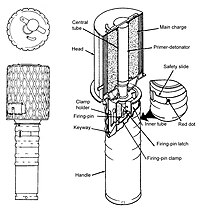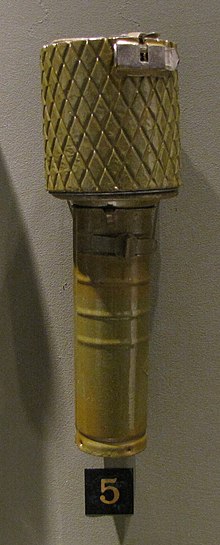RGD-33 grenade
| RGD-33 grenade | |
|---|---|
 A diagram of a RGD-33, with a fragmentation sleeve fitted and a cutaway. | |
| Type | Hand grenade |
| Place of origin | |
| Service history | |
| Used by | Soviet Union Khmer Rouge |
| Wars | World War II, Hukbalahap Rebellion, Korean War, Vietnam War |
| Production history | |
| Designed | 1933 |
| Produced | 1933-? |
| Specifications | |
| Mass | 500g, 750g with fragmentation sleeve |
| Length | 190mm |
| Diameter | 45mm, 54mm with fragmentation sleeve |
| Filling | TNT |
| Filling weight | 85g |
Detonation mechanism | Time-fuse, 4-5 seconds |

The Soviet RGD-33 is an anti-personnel fragmentation stick grenade developed in 1933. It was designed to replace the ageing Model 1914 grenade and was used during World War II.
Before use, a locking catch on the handle must be released and a fuse, lasting an average of 4 seconds, was inserted into the top of the can. A good throw could send the grenade 30 to 40 metres. Upon detonation the shells fragment in rectangular, thin fragments, which, along with the casing and detonator fragments, decelerate rapidly in air. Due to the fragments' rapid loss of velocity, the kill radius is small, making this grenade an "offensive" type. The fragmentation kill radius was approximately 15 metres with the sleeve and 10 metres without. As with most grenades of this era, there is potential for large fragment projection a great distance further than the throw.
The grenade was unusual but not unique, in that it had an optional "jacket" – a thick metal fragmentation sleeve weighing an average of 270 grams. When fitted over the grenade the sleeve improves the kill radius by producing a number of diamond-shaped, heavier fragments. With the jacket installed the grenade was said to be in "defensive" mode.
The grenade was complicated to use and manufacture. After the German invasion of the USSR, the simple and crude RG-42 was developed to slowly replace it.
